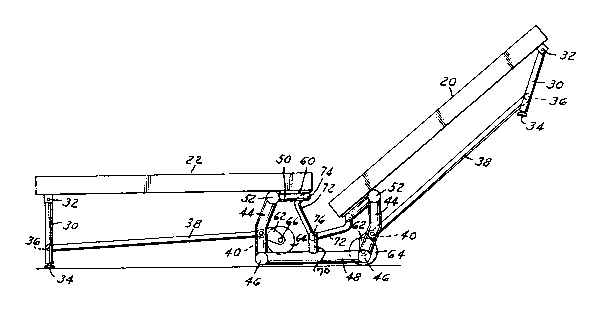Une partie des informations de ce site Web a été fournie par des sources externes. Le gouvernement du Canada n'assume aucune responsabilité concernant la précision, l'actualité ou la fiabilité des informations fournies par les sources externes. Les utilisateurs qui désirent employer cette information devraient consulter directement la source des informations. Le contenu fourni par les sources externes n'est pas assujetti aux exigences sur les langues officielles, la protection des renseignements personnels et l'accessibilité.
L'apparition de différences dans le texte et l'image des Revendications et de l'Abrégé dépend du moment auquel le document est publié. Les textes des Revendications et de l'Abrégé sont affichés :
| (12) Brevet: | (11) CA 1303640 |
|---|---|
| (21) Numéro de la demande: | 1303640 |
| (54) Titre français: | SCENE REPLIABLE MOBILE SUR ROULETTES |
| (54) Titre anglais: | FOLD AND ROLL STAGING |
| Statut: | Périmé et au-delà du délai pour l’annulation |
| (51) Classification internationale des brevets (CIB): |
|
|---|---|
| (72) Inventeurs : |
|
| (73) Titulaires : |
|
| (71) Demandeurs : |
|
| (74) Agent: | MARKS & CLERK |
| (74) Co-agent: | |
| (45) Délivré: | 1992-06-16 |
| (22) Date de dépôt: | 1988-07-06 |
| Licence disponible: | S.O. |
| Cédé au domaine public: | S.O. |
| (25) Langue des documents déposés: | Anglais |
| Traité de coopération en matière de brevets (PCT): | Non |
|---|
| (30) Données de priorité de la demande: | ||||||
|---|---|---|---|---|---|---|
|
ABSTRACT OF THE DISCLOSURE
A portable and foldable platform stage assembly has
two support panels movable from a collapsed position with panels
closely adjacent each other to an operative position with the
panels in a single plane, the inner edges in substantial contact.
Roller wheels move from a storage position when the panels are
in operative position to a floor contacting position when the
panels are collapsed for storage or movement. Outer legs move
from a storage position to a vertical operative position when
the panels are shifted to operative position. A central support
frame pivotally supports the inner edges of the platform panels
in the two positions with shaped spaced support links which
provide positive support in the operative position and adapt to
a receiving position when the panels are moved to storage
positions.
Note : Les revendications sont présentées dans la langue officielle dans laquelle elles ont été soumises.
Note : Les descriptions sont présentées dans la langue officielle dans laquelle elles ont été soumises.

2024-08-01 : Dans le cadre de la transition vers les Brevets de nouvelle génération (BNG), la base de données sur les brevets canadiens (BDBC) contient désormais un Historique d'événement plus détaillé, qui reproduit le Journal des événements de notre nouvelle solution interne.
Veuillez noter que les événements débutant par « Inactive : » se réfèrent à des événements qui ne sont plus utilisés dans notre nouvelle solution interne.
Pour une meilleure compréhension de l'état de la demande ou brevet qui figure sur cette page, la rubrique Mise en garde , et les descriptions de Brevet , Historique d'événement , Taxes périodiques et Historique des paiements devraient être consultées.
| Description | Date |
|---|---|
| Le délai pour l'annulation est expiré | 2008-06-16 |
| Lettre envoyée | 2007-06-18 |
| Inactive : CIB de MCD | 2006-03-11 |
| Inactive : CIB de MCD | 2006-03-11 |
| Accordé par délivrance | 1992-06-16 |
Il n'y a pas d'historique d'abandonnement
| Type de taxes | Anniversaire | Échéance | Date payée |
|---|---|---|---|
| TM (catégorie 1, 5e anniv.) - générale | 1997-06-16 | 1997-05-29 | |
| TM (catégorie 1, 6e anniv.) - générale | 1998-06-16 | 1998-05-28 | |
| TM (catégorie 1, 7e anniv.) - générale | 1999-06-16 | 1999-06-03 | |
| TM (catégorie 1, 8e anniv.) - générale | 2000-06-16 | 2000-06-02 | |
| TM (catégorie 1, 9e anniv.) - générale | 2001-06-18 | 2001-06-04 | |
| TM (catégorie 1, 10e anniv.) - générale | 2002-06-17 | 2002-05-31 | |
| TM (catégorie 1, 11e anniv.) - générale | 2003-06-16 | 2003-06-03 | |
| TM (catégorie 1, 12e anniv.) - générale | 2004-06-16 | 2004-06-03 | |
| TM (catégorie 1, 13e anniv.) - générale | 2005-06-16 | 2005-06-03 | |
| TM (catégorie 1, 14e anniv.) - générale | 2006-06-16 | 2006-05-30 |
Les titulaires actuels et antérieures au dossier sont affichés en ordre alphabétique.
| Titulaires actuels au dossier |
|---|
| STAGERIGHT CORPORATION |
| Titulaires antérieures au dossier |
|---|
| KENNETH EDWARD STATEN |
| ORLEY DAVID ROGERS |